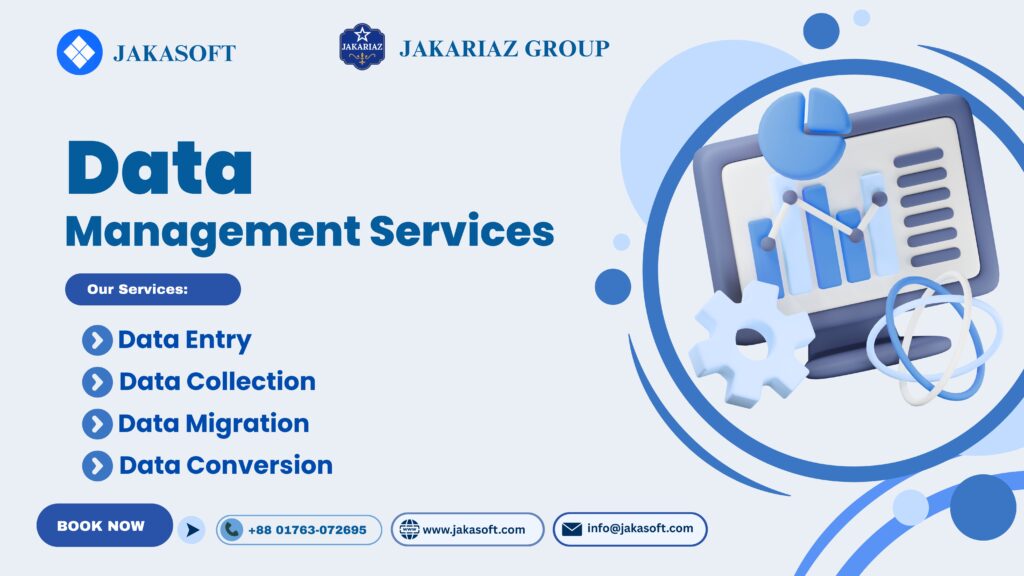Data Management Projects
Optimize Your Data, Empower Your Business
At JakaSoft, our Data Management Services help you organize, secure, and leverage your data for smarter decision-making. From data cleansing and integration to analytics and reporting, we provide tailored solutions that improve efficiency, accuracy, and business insights.

Data Management Projects
Turn Data into Decisions. Insights. Growth.
Prepared by JakaSoft – Digital & Data Solutions


1. Project Objective
To design and implement a comprehensive data management system that ensures data accuracy, accessibility, and security — enabling smarter decisions, improved efficiency, and sustainable business growth.
Our goal is to transform raw data into actionable intelligence, empowering organizations to make confident, data-driven decisions.
2. Project Goals & Key Performance Indicators (KPIs)
| Goal | Key Performance Indicator (KPI) |
|---|---|
| Centralize and organize business data | Unified database with streamlined data flow |
| Improve data accuracy & reliability | Reduction in data errors or duplications |
| Enhance reporting & analytics | Faster data retrieval and visual insights |
| Strengthen data security | Compliance with data privacy & protection standards |
| Enable decision-making | Real-time dashboards & improved data access |
3. Project Phases & Deliverables
Phase 1: Discovery & Data Audit (Week 1–2)
Deliverables:
-
Business requirements gathering
-
Current data systems assessment
-
Data source mapping (CRM, ERP, social, e-commerce, etc.)
-
Identification of gaps, redundancies, and inefficiencies
-
Project scope & data architecture plan
Tools Used: Microsoft Excel, Power BI, SQL, Google Sheets, Tableau
Phase 2: Data Collection & Integration (Month 1–2)
Deliverables:
-
Data extraction from multiple sources (manual or automated)
-
Data cleaning, validation, and normalization
-
Database creation or cloud data warehouse setup (SQL, BigQuery, etc.)
-
ETL (Extract, Transform, Load) process configuration
-
API integration for real-time data sync
KPIs:
-
100% successful data migration
-
Consistent data formatting across sources
-
Reduced duplication and missing values
Phase 3: Database Design & Management (Month 2–3)
Deliverables:
-
Relational database design (ER diagrams, schemas)
-
Data storage optimization for performance and scalability
-
Implementation of indexing and query optimization
-
Role-based access control and permission setup
-
Backup and recovery plan configuration
KPIs:
-
Optimized data retrieval time
-
Secure and scalable database environment
Phase 4: Data Analytics & Visualization (Month 3–4)
Deliverables:
-
KPI dashboard development (Power BI, Tableau, or Google Data Studio)
-
Real-time reporting systems
-
Data trend analysis and forecasting models
-
Integration with marketing, sales, or finance systems
-
Custom reports for management decision-making
KPIs:
-
Improved reporting efficiency
-
Visual insights for key stakeholders
-
Increased data-driven decision-making adoption
Phase 5: Data Security & Compliance (Month 4–5)
Deliverables:
-
Implementation of encryption and secure access protocols
-
GDPR, HIPAA, or regional data compliance audits
-
Security monitoring and access log configuration
-
Regular data integrity checks and validation scripts
-
Disaster recovery and data backup policies
KPIs:
-
100% compliance with data regulations
-
Zero data breaches or unauthorized access
Phase 6: Automation & Maintenance (Month 5–6)
Deliverables:
-
Automated data entry, validation, and reporting workflows
-
Scheduled backups and performance monitoring
-
System optimization for speed and reliability
-
Training for staff on data management best practices
-
Ongoing maintenance & technical support plan
KPIs:
-
Reduced manual workload
-
Faster reporting and decision-making cycles
-
High system uptime and reliability
4. Tools & Technologies
| Category | Tools / Platforms |
|---|---|
| Databases | MySQL, PostgreSQL, MongoDB, Microsoft SQL Server |
| Data Visualization | Power BI, Tableau, Google Data Studio |
| ETL / Data Integration | Talend, Apache NiFi, Airbyte |
| Cloud Platforms | Google Cloud, AWS, Azure |
| Automation & Scripting | Python, R, Excel Macros, Zapier |
| Security & Compliance | SSL, Encryption Tools, Access Control Systems |
5. Target Clients / Who We Help
-
Small to Large Businesses
-
E-commerce & Retail Companies
-
Financial Institutions
-
SaaS & Tech Startups
-
Healthcare & Educational Organizations
-
NGOs & Government Agencies
6. Why Choose JakaSoft






7. Example Project Timeline (6 Months)
| Month | Activities |
|---|---|
| 1 | Discovery, Audit, and Data Mapping |
| 2 | Integration & Database Setup |
| 3 | Data Structuring and Testing |
| 4 | Dashboard & Analytics Development |
| 5 | Security Implementation & Compliance Review |
| 6 | Automation, Training, and Maintenance |
8. Reporting & Monitoring
Deliverables:
-
Monthly progress reports (Data updates, analytics, performance)
-
Dashboard sharing & version control system
-
Data integrity reports and audit logs
-
Recommendations for system improvement
9. Expected Outcomes
-
Centralized, clean, and accessible data infrastructure
-
99% data accuracy and reduced manual data entry
-
Enhanced business intelligence and reporting speed
-
Compliance with data privacy regulations
-
Long-term scalability and automation
10. Let’s Build Your Data-Driven Future
At JakaSoft, we don’t just manage data — we transform it into a strategic business asset.
Let’s design a data management system that gives your organization the clarity and confidence to make smarter, faster decisions.


